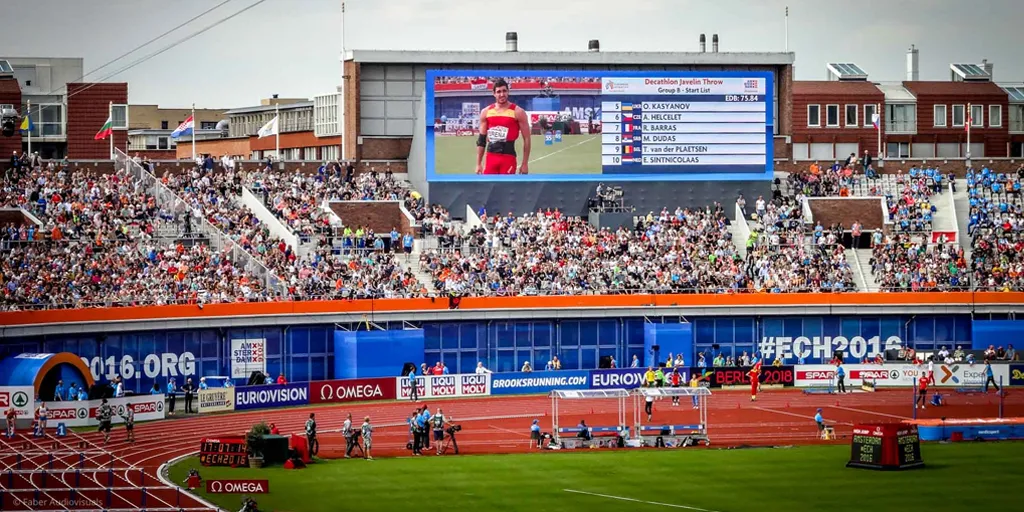
About LED displays used in stadiums
Introduction:

The Benefits of Stadium LED Screens
The journey of stadium displays began with traditional scoreboards and has evolved significantly with advancements in LED technology. Early displays were limited to showing scores and basic information. However, the introduction of LED technology brought higher brightness, better color accuracy, and greater flexibility in display capabilities.
-
Brightness and Visibility: LED screens offer exceptional brightness levels, ensuring visibility even in direct sunlight. This makes them ideal for outdoor stadiums.
-
Energy Efficiency: LEDs consume less power compared to traditional lighting systems, reducing operational costs.
-
Longevity: LED screens have a longer lifespan, often exceeding 100,000 hours of use.
-
Flexibility: LED screens can display a wide range of content, from live video feeds to dynamic advertisements and instant replays.

Key Features of Stadium LED Screens
High Resolution and Clarity
Modern stadium LED screens boast high resolutions, providing crystal-clear images and videos. This clarity is crucial for fans seated far from the screen, ensuring everyone in the stadium can enjoy the same high-quality viewing experience.
Real-Time Content Display
One of the most significant advantages of LED screens is their ability to display real-time content. This includes live game footage, instant replays, player statistics, and interactive fan messages. This dynamic content keeps the audience engaged and enhances the overall event experience.
Versatility
Stadium LED screens are incredibly versatile. They can be used for various purposes, such as:
-
Game Information: Displaying scores, time, and other game-related data.
-
Advertising: Providing a platform for dynamic and engaging advertisements.
-
Fan Engagement: Featuring fan cams, social media feeds, and interactive content.
-
Event Information: Announcing upcoming events, safety messages, and other important notices.

Durability and Weather Resistance
Designed to withstand harsh weather conditions, stadium LED displays are built with durable materials. They are water-resistant, dust-proof, and capable of operating in extreme temperatures, ensuring reliable performance year-round.
The Technology Behind Stadium LED Screens
Stadium LED screens comprise thousands of tiny light-emitting diodes (LEDs) arranged in a grid pattern. These LEDs can produce a wide range of colors by combining red, green, and blue (RGB) light. The key technological aspects include:
Pixel Pitch
Pixel pitch refers to the distance between the centers of two adjacent LEDs. A smaller pixel pitch results in higher resolution and better image quality. For large stadium screens, a balance between pixel pitch and viewing distance is crucial to optimize clarity and cost.
Refresh Rate
The refresh rate determines how often the image on the screen is updated per second. A higher refresh rate ensures smoother motion and reduces flicker, which is especially important for fast-paced sports events.
Brightness and Contrast
High brightness levels ensure that the screen remains visible under various lighting conditions. Contrast ratio, the difference between the darkest and brightest parts of the image, enhances the overall visual experience by providing deeper blacks and brighter whites.
The Future of Stadium LED Screens
As technology continues to evolve, stadium LED screens are expected to become even more advanced. Some future trends include:
4K and 8K Resolutions
Higher resolution screens will provide even more detailed and immersive viewing experiences. 4K and 8K resolutions are becoming more accessible and may become the standard for new installations.
Integration with Augmented Reality (AR)
Integrating AR with stadium screens can create interactive experiences for fans. This technology can provide real-time stats, player information, and other interactive elements overlaid on the live action.
Advanced Analytics and AI
AI and advanced analytics can optimize content display based on audience engagement, preferences, and real-time data. This can enhance advertising effectiveness and improve fan engagement strategies.
Conclusion
In conclusion, stadium LED screens have transformed the live event experience, offering unparalleled visibility, versatility, and engagement opportunities. As technology continues to advance, these screens will play an even more significant role in shaping the future of sports and entertainment venues. Whether you’re a fan, a stadium operator, or a business looking to advertise, understanding the capabilities and potential of stadium LED displays is essential in today’s digital age.